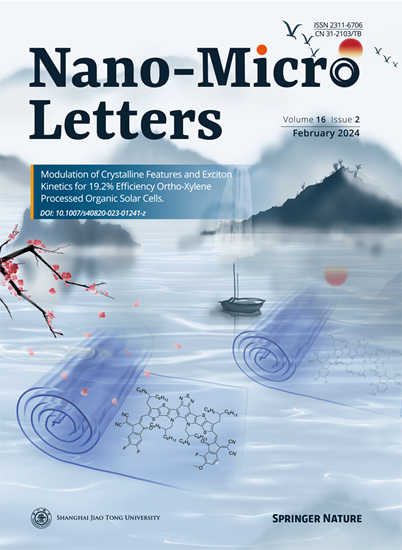金属-支撑相互作用诱导电子定位在合理设计的金属位点锚定MXene增强电磁波衰减。
IF 36.3
1区 材料科学
Q1 Engineering
引用次数: 0
摘要
电子局域化被认为是一种很有前途的优化电磁波耗散的方法。然而,目前的研究仍然难以实现可控的电子定位和阐明相关的EMW损耗机制。在本研究中,探索了一种新型的二维Ni纳米簇修饰MXene (Ti3C2Tx)纳米片(Ni- nc)系统,以构建一个有效的基于电子轨道结构的电子定位模型。理论模拟和实验结果表明,Ni-NC和MXene之间的金属支撑相互作用破坏了对称电子环境,导致电子局域化和偶极极化增强。此外,Ni-NC产生强大的界面电场,加强异质界面相互作用,促进界面极化。因此,优化后的材料实现了- 54 dB的卓越反射损耗(RLmin)和6.8 GHz的宽有效吸收带宽。这项研究为电子局域化和EMW耗散之间的深入关系提供了重要的见解,为半导体、自旋电子学和催化等功能材料的电子局域化工程提供了途径。本文章由计算机程序翻译,如有差异,请以英文原文为准。
Metal–Support Interaction Induced Electron Localization in Rationally Designed Metal Sites Anchored MXene Enables Boosted Electromagnetic Wave Attenuation
Highlights
-
It is found that the reconstruction of the electronic environment and the optimization of the electromagnetic attenuation mechanism are achieved by constructing a model of metal–support interaction regulated electron localization.
-
An excellent RLmin of − 54 dB and an ultra-wide effective absorption bandwidth of 6.8 GHz are obtained in the 2D MXene system.
-
The microscopic pathway of “local field-driven carrier migration → interfacial electron rearrangement → dipole polarization enhancement” has been elucidated.
求助全文
通过发布文献求助,成功后即可免费获取论文全文。
去求助
来源期刊

Nano-Micro Letters
NANOSCIENCE & NANOTECHNOLOGY-MATERIALS SCIENCE, MULTIDISCIPLINARY
CiteScore
32.60
自引率
4.90%
发文量
981
审稿时长
1.1 months
期刊介绍:
Nano-Micro Letters is a peer-reviewed, international, interdisciplinary, and open-access journal published under the SpringerOpen brand.
Nano-Micro Letters focuses on the science, experiments, engineering, technologies, and applications of nano- or microscale structures and systems in various fields such as physics, chemistry, biology, material science, and pharmacy.It also explores the expanding interfaces between these fields.
Nano-Micro Letters particularly emphasizes the bottom-up approach in the length scale from nano to micro. This approach is crucial for achieving industrial applications in nanotechnology, as it involves the assembly, modification, and control of nanostructures on a microscale.
 求助内容:
求助内容: 应助结果提醒方式:
应助结果提醒方式:


